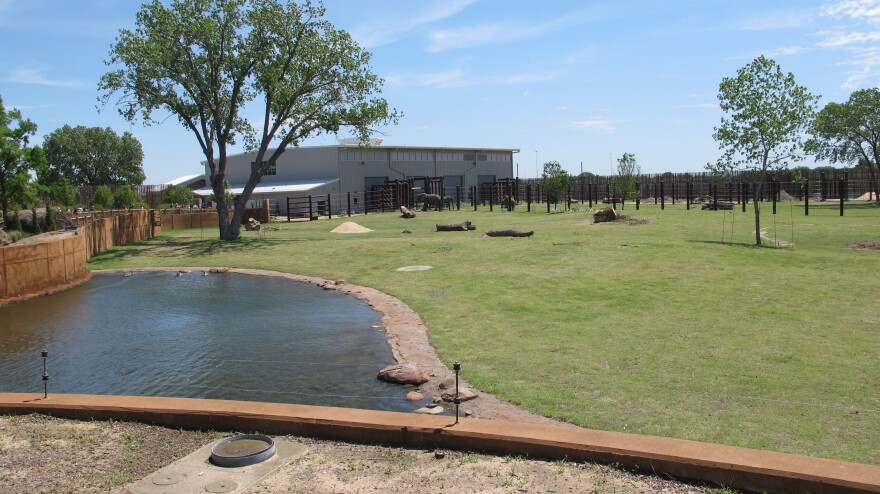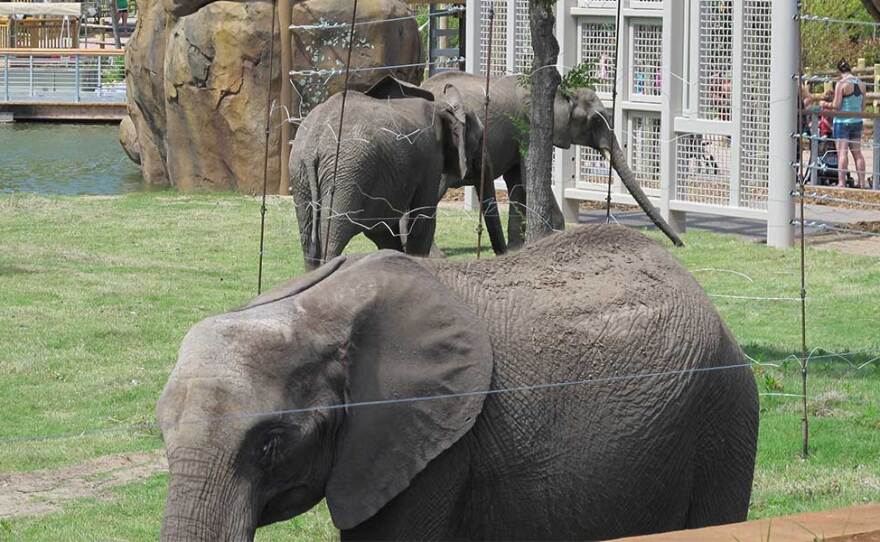The new elephant exhibit at the Sedgwick County Zoo in Wichita is officially open.
The state-of-the-art facility is getting a lot of attention, and not just for the impressive grounds. As KMUW’s Deborah Shaar tells us, visitors are excited to see the six new elephants from Africa.
The winding trail through the Pride of the Plains area at the Sedgwick County Zoo leads to the entrance of the zoo’s newest and most expensive exhibit: the Reed Family Elephants of the Zambezi River Valley.

Volunteers from Wichita businesses are serving as guides on this preview day for zoo members. Visitors might know the zoo’s longtime elephant, Stephanie; she’s been here for more than 40 years. The rest of the herd, six elephants from Africa, arrived just two months ago.
Zookeepers don’t know for sure but are guessing that the one male and four female elephants from Africa are about six to eight years old. The other new elephant is an adult female, about 18 years old. She is the same height as Stephanie, but a bit smaller in stature.
Zookeeper Mary Zachar has been caring for the animals since they arrived.
"They’re a little small for their age," Zachar says. "We’re working on bringing up their weight. We’ve been a steady increase of weight since they’ve gotten here, which is great to see."

Sarah Hensiek is bringing a few first-graders from Sunset Elementary in Newton into the exhibit. They find a spot along the railing, in a big covered pavilion that overlooks two elephant yards. A few elephants are roaming around. The area is roughly five acres of grass and dirt. The large elephant barn is at one end, and a huge pool is at the other. There's a stream; a few trees lie on the ground.
Zachar says there’s a purpose to the design.
"We want to encourage as many natural behaviors as possible," she says. "There are a whole bunch of features out on the yards that are meant to keep [the elphants] interested. We’ve got sand mounds for them to dust in, sleep on. We have mud wallows, which the kids love to play in."

The “kids,” the younger elephants in the herd, need social time together as part of the transition process. Because the new group came from two different herds in Africa, they need to get used to each other, as well as adjust to a new environment.
"We’ve got all five of our juveniles together at one point of time or another during the day," Zachar says. "It’s still not a solid group yet. That’s going to take some time. They need to figure out who’s who in the pecking order, who’s the most dominant, who’s the most submissive. And they need to get used to each other."
The new herd met the zoo’s longtime elephant, Stephanie, when they first arrived. For now, Stephanie is being kept in a separate area, but she can still see, hear and smell the new elephants.
"Right now, what we’re seeing is very positive," Zachar says. "She’s very interested in them. She’s always interacting with them between the fence or through the stall walls. She’s always very concerned if she hears two of the little kids getting a little rough with each other. She comes rushing up; she’s like their aunt."
The zookeepers expect Stephanie to keep her role as the dominant female in the new herd, due to her age and size.

The elephants from Africa are settling into their new home and getting used to the six people who take care of them. The zookeepers are seeing progress with establishing daily routines and basic target training.
"They’re already used to people," Zachar says. "They know that people mean food, so they come up to us as soon as they see us. They’ve learned their names already... They know to come when they’re called."
“What are their names?” is usually the first question zoo volunteers and staff get when visitors arrive at the new exhibit. The elephants were given African names to honor their birthplace.
Zoo officials say these elephants, no matter what you call them, were facing conditions in Africa where a historic drought threatened their food source and poachers threatened their welfare.

Now, their days will be spent in the third-largest elephant habitat in the U.S. The new barn is state-of-the-art and large enough to hold up to nine elephants.
Zookeeper Mary Zachar says two separate training walls are used for enrichment activities and medical check-ups.
"We have windows where we can ask them to stick their feet out so we can do foot work," Zachar says. "We have ear ports so they can stick their ears out and we can do blood draws, which is very important for these elephants."
The new elephant exhibit is the result of 16 years of planning, and about two years of construction and finishing work.

The zoo needed to expand its herd and facilities to comply with Association of Zoos and Aquariums standards. The exhibit cost about $10.6 million.
The zoo has long been considered the number-one outdoor family tourist attraction in Kansas--and that status likely won’t change this summer. With new elephants and a new exhibit on display, the zoo’s expecting record crowds.
--
Follow Deborah Shaar on Twitter @deborahshaar
To contact KMUW News or to send in a news tip, reach us at news@kmuw.org.







